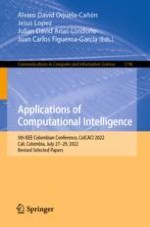2023 | Book
Applications of Computational Intelligence
5th IEEE Colombian Conference, ColCACI 2022, Cali, Colombia, July 27–29, 2022, Revised Selected Papers
Editors: Alvaro David Orjuela-Cañón, Jesus Lopez, Julian David Arias-Londoño, Juan Carlos Figueroa-García
Publisher: Springer Nature Switzerland
Book Series : Communications in Computer and Information Science
